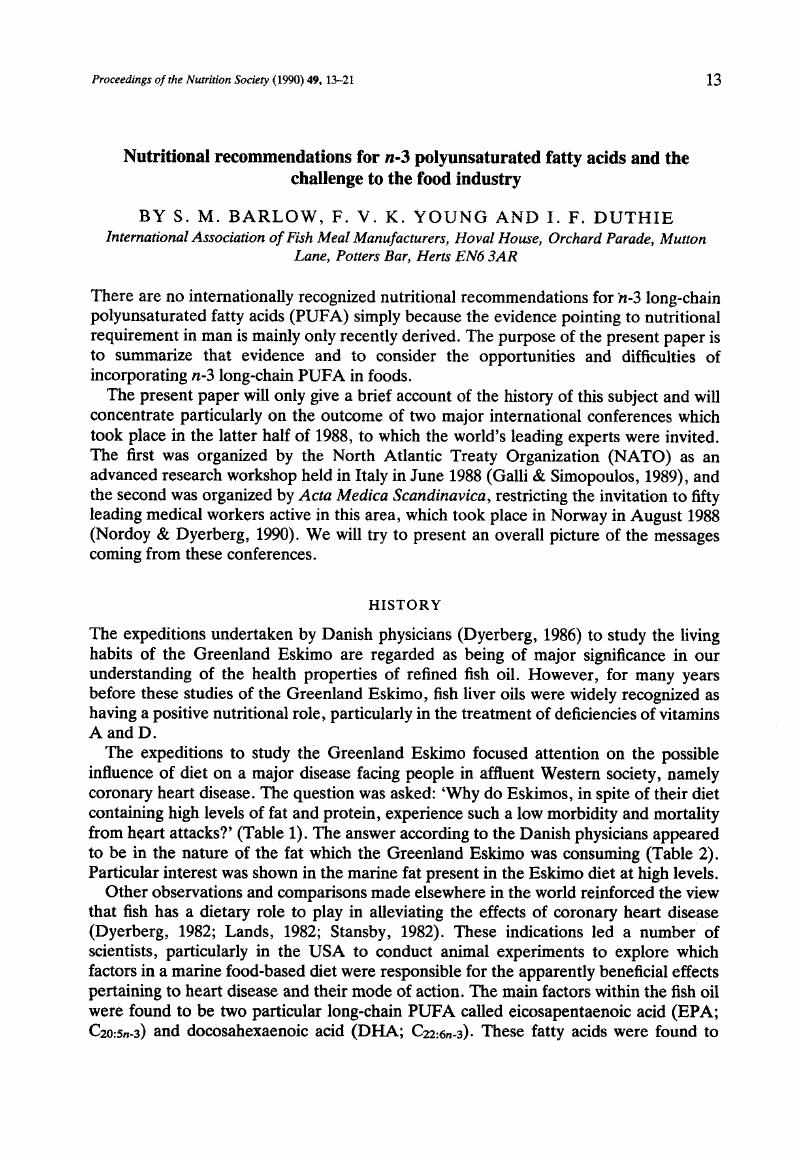Crossref Citations
This article has been cited by the following publications. This list is generated based on data provided by Crossref.
Raederstorff, D.
Meier, C. A.
Moser, U.
and
Walter, P.
1991.
Hypothyroidism and thyroxin substitution affect the n−3 fatty acid composition of rat liver mitochondria.
Lipids,
Vol. 26,
Issue. 10,
p.
781.
Shantha, N.C.
and
Ackman, R.G.
1991.
Silica Gel Thin-Layer Chromatographic Method for Concentration of Longer-Chain Polyunsaturated Fatty Acids From Food and Marine Lipids.
Canadian Institute of Food Science and Technology Journal,
Vol. 24,
Issue. 3-4,
p.
156.
Faustman, C.
1993.
Technology of Reduced-Additive Foods.
p.
160.
Hargis, Pamela S.
and
Van Elswyk, Mary E.
1993.
Manipulating the fatty acid composition of poultry meat and eggs for the health conscious consumer.
World's Poultry Science Journal,
Vol. 49,
Issue. 3,
p.
251.
Dänicke, S.
Zachmann, R.
Böttcher, W.
and
Jeroch, H.
1995.
Einfluß gestaffelter Rapssaatanteile im Legehennenfutter auf das Fettsäurenmuster des Eifettes unter besonderer Berücksichtigung der polyungesättigten Fettsäuren.
Lipid / Fett,
Vol. 97,
Issue. 5,
p.
194.
Leskanich, C.O.
and
Noble, R.C.
1997.
Manipulation of then-3 polyunsaturated fatty acid composition of avian eggs and meat.
World's Poultry Science Journal,
Vol. 53,
Issue. 2,
p.
155.
Van Oeckel, Monique J.
Casteels, M.
Warnants, Nathalie
and
Boucqu, Ch. V.
1997.
Omega‐3 fatty acids in pig nutrition: Implications for zootechnical performances, carcass and fat quality1.
Archiv für Tierernaehrung,
Vol. 50,
Issue. 1,
p.
31.
Bengmark, Stig
1998.
Ecoimmunonutrition: a challenge for the third millennium.
Nutrition,
Vol. 14,
Issue. 7-8,
p.
563.
Bernardini, M.
Dal Bosco, A.
and
Castellini, C.
1999.
Effect of dietary n-3/n-6 ratio on fatty acid composition of liver, meat and perirenal fat in rabbits.
Animal Science,
Vol. 68,
Issue. 4,
p.
647.
Gonzalez-Esquerra, R.
and
Leeson, S.
2000.
Effect of feeding hens regular or deodorized menhaden oil on production parameters, yolk fatty acid profile, and sensory quality of eggs.
Poultry Science,
Vol. 79,
Issue. 11,
p.
1597.
Baucells, M.D.
Crespo, N.
Barroeta, A.C.
López-Ferrer, S.
and
Grashorn, M.A.
2000.
Incorporation of different polyunsaturated fatty acids into eggs.
Poultry Science,
Vol. 79,
Issue. 1,
p.
51.
Scollan, Nigel D.
Choi, Nag-Jin
Kurt, Esra
Fisher, Alan V.
Enser, Mike
and
Wood, Jeff D.
2001.
Manipulating the fatty acid composition of muscle and adipose tissue in beef cattle.
British Journal of Nutrition,
Vol. 85,
Issue. 1,
p.
115.
IRIANTO, HARI EKO
FAWZYA, YUSRO NURI
SUGIYONO
and
ANGGRENANI, SANTI
2002.
Use of sardine oil for medium of canned skipjack.
Fisheries science,
Vol. 68,
Issue. sup2,
p.
1430.
Gildberg, A.
2002.
Safety and Quality Issues in Fish Processing.
p.
425.
Faustman, Cameron
2004.
Technology of Reduced Additive Foods.
p.
162.
Raes, K.
De Smet, S.
and
Demeyer, D.
2004.
Effect of dietary fatty acids on incorporation of long chain polyunsaturated fatty acids and conjugated linoleic acid in lamb, beef and pork meat: a review.
Animal Feed Science and Technology,
Vol. 113,
Issue. 1-4,
p.
199.
Pan, Xiangqing
Kaneko, Hiroyuki
Ushio, Hideki
and
Ohshima, Toshiaki
2005.
Oxidation of all‐
cis
‐7,10,13,16,19‐docosapentaenoic acid ethyl ester. Hydroperoxide distribution and volatile characterization
.
European Journal of Lipid Science and Technology,
Vol. 107,
Issue. 4,
p.
228.
Sanz Sampelayo, M.R.
Fernández, J.R.
Ramos, E.
Hermoso, R.
Gil Extremera, F.
and
Boza, J.
2006.
Effect of providing a polyunsaturated fatty acid-rich protected fat to lactating goats on growth and body composition of suckling goat kids.
Animal Science,
Vol. 82,
Issue. 3,
p.
337.
Scerra, M.
Caparra, P.
Foti, F.
Galofaro, V.
Sinatra, M.C.
and
Scerra, V.
2007.
Influence of ewe feeding systems on fatty acid composition of suckling lambs.
Meat Science,
Vol. 76,
Issue. 3,
p.
390.
García Navarro, M.C.
Ramos Morales, E.
De la Torre Adarve, G.
Fernández Navarro, J.R.
Rodríguez Osorio, M.
Gil Extremera, F.
and
Sanz Sampelayo, M.R.
2008.
Growth of Pre-ruminant Kid Goats and the Composition of Carcass Fat Deposits: Effects of Providing a PUFA-rich Fat in the Milk Replacer and Influence of the Kidding Season.
Food Science and Technology International,
Vol. 14,
Issue. 5_suppl,
p.
85.



